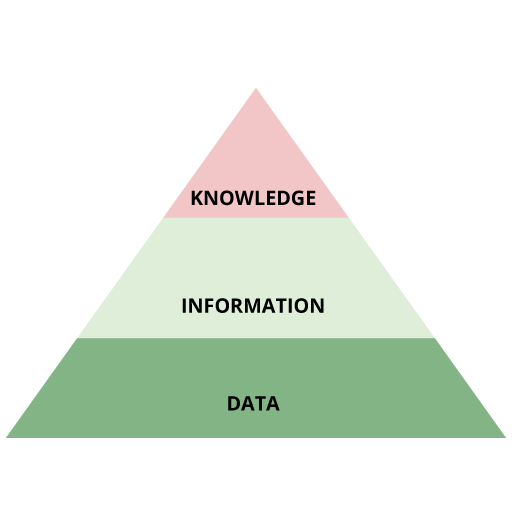Use 'Print preview' to check the number of pages and printer settings.
Print functionality varies between browsers.
Printable page generated Wednesday, 24 April 2024, 5:13 PM
Unit 3 The Evidence Pyramid
Introduction
In this Unit, you will be introduced to the concept of the
People use the word ‘
Evidence from different types of sources (e.g. media stories, expert reports, policies and research) can be classified into three levels of analysis:
- Data – raw data without meaning, e.g. numbers, words.
- Information – data with attached meaning for ‘who, what, where’.
- Knowledge – information with insight, know-how for ‘why and how’ it can be used.
3.1 Evidence typologies
There is a distinct difference between ‘
Evidence typologies and migration
The process of turning data into information and then again into knowledge is complicated and time-consuming. This results in many migration issues having a wealth of data, some of which is turned into information, but little is actually translated into valuable knowledge. The
The Evidence Pyramid is a visual representation of different levels of evidence analysis that can be built upon to transform raw data into meaningful information and thus into actionable knowledge. It can also support a deeper understanding of the larger quantity of
3.2 Evidence Cafés and discussion objects
As you will have learned in Unit 1, Evidence Cafés are an effective way of collecting different views on a variety of evidence types for a complex topic.
When stakeholders share evidence as part of a migration Evidence Café, they often talk about evidence that has been analysed at different levels, providing different levels of insight. One person may be discussing an issue evidenced with research knowledge, underpinned by a well-structured framework. Another person could be discussing quotes from migrants that they’ve recently heard. Whilst these are both valuable types of evidence, the former knowledge has been analysed to a greater depth and is more effectively turned into actions than the latter data. The knowledge exchange process within Evidence Cafés should help to identify these differences and support the development of further types of evidence. This creates and encourages stakeholders to work together to find migration solutions, rather than believing that one piece of evidence has all the answers.
3.3 The Evidence Pyramid
The
The Evidence Pyramid (Figure 3.1) can be used in a collaborative exercise to categorise evidence collected from different viewpoints:
- Multiple voices then place their understanding on a joint data map (numbers or captured verbal accounts/images)
- How much data has been turned into information (through identifying meaning attached to that data)?
- What knowledge has been developed (understanding, theory, frameworks)?
The activity needs to be collaborative, around a collective discussion object (i.e. a printed version of the evidence pyramid). Frequently this is enacted through Post-It notes attached to a representation of the triangle.
With migration, there is an additional issue of access to data for analysis, to extract information and then knowledge. For example, many immigration records are not openly available, and the data is often incomplete, poorly captured and thus likely to be inaccurate and corrupted. Data sharing within migration studies therefore becomes a major issue when developing good quality information and knowledge to enable effective migration solutions; something we discuss in more detail in the next Unit.
 Activity 3.1 Evidence Pyramid
Activity 3.1 Evidence Pyramid
Part 1
Look at the three pieces of evidence and place them onto the Evidence Pyramid according to the definitions above as data, information or knowledge. Once you have finished, click 'submit'. You can try as many times as you like.
Part 2
- Now, review the difference between data, information and knowledge and how easy it is to identify migration data, information or knowledge. Do you think this relates to the quantities of migration data and limited migration knowledge?
- Then, reflect upon how the translation of data to knowledge could be enabled using an Evidence Café. Think about bringing together the different stakeholders who have the power to support access to and development of, migration data into knowledge?
Now that you have reviewed in more depth how to categorise evidence, you need to understand how to share this understanding between different stakeholders. Discussion objects (introduced in Section 2.2 and discussed in more detail in this Unit) provide a useful way of enabling and supporting communication between different stakeholders. Activity 3.2 looks at this in more detail.
 Activity 3.2 Review the role of a discussion object
Activity 3.2 Review the role of a discussion object
Part1
From your own experiences, consider objects or resources that you have used as discussion points and help share understanding. Below are some ideas that you may have experienced. Consider these and your own ideas.
- The use of mind maps in a workshop.
- A board game that you and your family/friends are playing together.
- A puzzle that you and your family/friends are completing together.
- A cooking recipe that you and your family/friends are making together.
Part 2
Now read page 3 of The Open University's Evidence Cafés: A how-to guide booklet. Consider the section on discussion objects in relation to your own experiences of using an object to share understanding.
Summary
Often when stakeholders share their arguments for migration they present evidence to justify their arguments. This Unit has supported you in understanding the distinct levels of evidence (data, information, knowledge) produced from different depths of analysis. This results in stakeholders using a different quality of evidence in their discussions. The
Unit learning outcomes:
- This Unit has developed your understanding of the Evidence Pyramid tool for knowledge exchange with migration issues.
- You have learned how to use the Evidence Pyramid to help you critically analyse evidence associated with a particular issue and, through an Evidence Café, to support communication and collaboration with those stakeholders.
- You now have an understanding of different levels of evidence to support migration knowledge exchange.
- You can use the Evidence Pyramid as a
discussion object within an Evidence Café to communicate with migration stakeholders. - You have practically applied the concept of evidence levels for the Evidence Pyramid to support you in applying this within your professional contexts.
In Unit 4 Migration evidence you will learn more about applying the concepts of ‘data’, ‘information’ and ‘knowledge’ within the Evidence Pyramid to real migration data. In particularyou would look at how migration evidence can be applied to facilitate knowledge exchange to answer migration questions.

